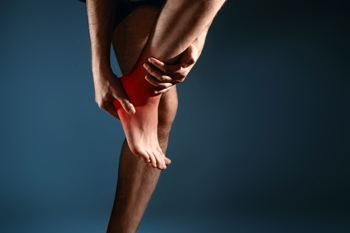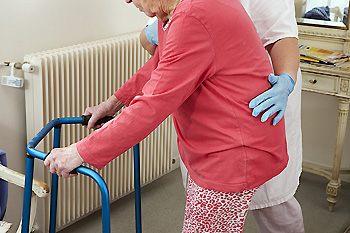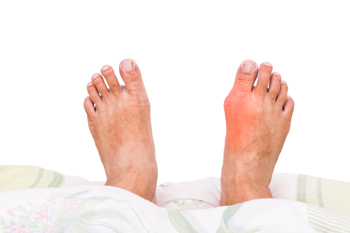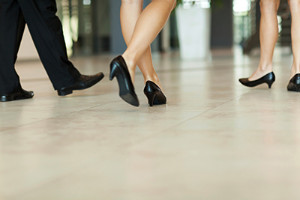Wesley Chapel
(813) 973-3535Call or Text
January 2021
Reminder: When Was the Last Time...?
Is Standing All Day Bad for Your Feet?
While it is true that standing for prolonged periods of time can burn more calories than sitting, there are also many foot and lower limb problems associated with prolonged standing. These can include blood pooling in the legs, leading to swelling and poor circulation, and foot and leg pain. Standing all day can also aggravate pre-existing foot conditions, such as bunions, corns, and calluses. If you must stand for long periods of time as part of your job, it is suggested that you sit down during breaks, gently stretch and massage the legs and feet, and apply ice to painful areas if pain becomes excessive. For more information about working on your feet, please consult with a podiatrist.
While working on the feet, it is important to take the proper care of them. For more information about working on your feet, contact one of our podiatrists from New Tampa Foot & Ankle. Our doctors will treat your foot and ankle needs.
Working on Your Feet
Standing on your feet for long periods of time can cause stress and pain in your feet. Your whole body may experience change in terms of posture, back pain, bunions, callouses and or plantar warts. There are ways to avoid these conditions with proper foot care, smart choices and correct posture.
Positive Changes
Negative heeled shoe – Choosing this shoe type places the heel slightly lower than the ball of the foot. These are great for overall foot health. Find shoes that fit you correctly.
Go barefoot – Our feet were not designed to be enclosed for all hours of the day. Try to periodically expose your feet to air.
Eliminate Pain
Foot Exercises – Performing simple exercises, incorporating yoga and doing stretches are beneficial. This will allow increased blood flow to the area and muscles of the foot.
Achilles tendon – Stretching the foot out flat on the floor will relax the calf muscles and tendon. These exercises can be performed almost anywhere. Make sure you add these exercises to your daily regimen.
With a little bit of this information and knowing more about foot health, you will notice changes. Foot stretches and proper footwear will help with pain and prevent further issues.
If you have any questions please feel free to contact our office located in Wesley Chapel, FL . We offer the newest diagnostic and treatment technologies for all your foot and ankle needs.
What Is a Peroneal Tendon Injury?
 The peroneal tendons are bands of tissue that run behind the outer ankle bone. These tendons stabilize the foot and ankle and protect them from sprains. People who participate in sports, especially those involving repetitive ankle motion, and people with high arches are at an increased risk of experiencing a peroneal tendon injury. This type of injury can be caused by inflammation, tearing, degeneration or dislocation of one or both peroneal tendons. Injury to the tendons can cause symptoms such as pain, swelling, warmth, weakness, or instability in the affected foot and ankle. If you are experiencing foot or ankle pain, it is suggested that you consult with a podiatrist.
The peroneal tendons are bands of tissue that run behind the outer ankle bone. These tendons stabilize the foot and ankle and protect them from sprains. People who participate in sports, especially those involving repetitive ankle motion, and people with high arches are at an increased risk of experiencing a peroneal tendon injury. This type of injury can be caused by inflammation, tearing, degeneration or dislocation of one or both peroneal tendons. Injury to the tendons can cause symptoms such as pain, swelling, warmth, weakness, or instability in the affected foot and ankle. If you are experiencing foot or ankle pain, it is suggested that you consult with a podiatrist.
Foot and ankle trauma is common among athletes and the elderly. If you have concerns that you may have experienced trauma to the foot and ankle, consult with one of our podiatrists from New Tampa Foot & Ankle. Our doctors will assess your condition and provide you with quality foot and ankle treatment.
Foot and ankle trauma cover a range of injuries all over the foot; common injuries include:
- Broken bones
- Muscle strains
- Injuries to the tendons and ligaments
- Stress fractures
Symptoms
Symptoms of foot and ankle injuries vary depending on the injury, but more common ones include:
- Bruising
- Inflammation/ Swelling
- Pain
Diagnosis
To properly diagnose the exact type of injury, podiatrists will conduct a number of different tests. Some of these include sensation and visual tests, X-rays, and MRIs. Medical and family histories will also be taken into account.
Treatment
Once the injury has been diagnosed, the podiatrist can than offer the best treatment options for you. In less severe cases, rest and keeping pressure off the foot may be all that’s necessary. Orthotics, such as a specially made shoes, or immobilization devices, like splints or casts, may be deemed necessary. Finally, if the injury is severe enough, surgery may be necessary.
If you have any questions, please feel free to contact our office located in Wesley Chapel, FL . We offer the newest diagnostic and treatment technologies for all your foot care needs.
Why Live with Pain and Numbness in Your Feet?
Falling Can Injure The Feet
 The number of falls that occur in elderly people worldwide increases every year. Research has indicated this may lead to foot injuries that can make it difficult to complete every day activities. Many falls happen in the home, and there are methods that can be implemented that can help to prevent falling. These can include removing worn rugs from the living area, and improving lighting in the household. Additionally, it is helpful to receive annual physical examinations in which existing medications are reviewed. Many patients find it helpful to install grab bars in the toilet and shower area, and falls may be minimized when a bathmat is placed on the shower floor. Please review fall prevention techniques with a podiatrist who can help you to prevent painful foot injuries.
The number of falls that occur in elderly people worldwide increases every year. Research has indicated this may lead to foot injuries that can make it difficult to complete every day activities. Many falls happen in the home, and there are methods that can be implemented that can help to prevent falling. These can include removing worn rugs from the living area, and improving lighting in the household. Additionally, it is helpful to receive annual physical examinations in which existing medications are reviewed. Many patients find it helpful to install grab bars in the toilet and shower area, and falls may be minimized when a bathmat is placed on the shower floor. Please review fall prevention techniques with a podiatrist who can help you to prevent painful foot injuries.
Preventing falls among the elderly is very important. If you are older and have fallen or fear that you are prone to falling, consult with one of our podiatrists from New Tampa Foot & Ankle. Our doctors will assess your condition and provide you with quality advice and care.
Every 11 seconds, an elderly American is being treated in an emergency room for a fall related injury. Falls are the leading cause of head and hip injuries for those 65 and older. Due to decreases in strength, balance, senses, and lack of awareness, elderly persons are very susceptible to falling. Thankfully, there are a number of things older persons can do to prevent falls.
How to Prevent Falls
Some effective methods that older persons can do to prevent falls include:
- Enrolling in strength and balance exercise program to increase balance and strength
- Periodically having your sight and hearing checked
- Discuss any medications you have with a doctor to see if it increases the risk of falling
- Clearing the house of falling hazards and installing devices like grab bars and railings
- Utilizing a walker or cane
- Wearing shoes that provide good support and cushioning
- Talking to family members about falling and increasing awareness
Falling can be a traumatic and embarrassing experience for elderly persons; this can make them less willing to leave the house, and less willing to talk to someone about their fears of falling. Doing such things, however, will increase the likelihood of tripping or losing one’s balance. Knowing the causes of falling and how to prevent them is the best way to mitigate the risk of serious injury.
If you have any questions, please feel free to contact our office located in Wesley Chapel, FL . We offer the newest diagnostic and treatment technologies for all your foot care needs.
What Can Cause Bunions?
 There are many potential causes of bunions. Foot injuries, such as sprains, fractures, or nerve damage can increase the risk of developing bunions. Some people are born with defects in the structure of their foot that lead to bunion formation later on. Bunions also tend to run in families. Certain structural problems in the feet, such as loose joints and tendons, flat feet, and low arches can make bunions more likely to form. Bunions are also linked to rheumatoid arthritis. To learn more about bunions, please consult with a podiatrist.
There are many potential causes of bunions. Foot injuries, such as sprains, fractures, or nerve damage can increase the risk of developing bunions. Some people are born with defects in the structure of their foot that lead to bunion formation later on. Bunions also tend to run in families. Certain structural problems in the feet, such as loose joints and tendons, flat feet, and low arches can make bunions more likely to form. Bunions are also linked to rheumatoid arthritis. To learn more about bunions, please consult with a podiatrist.
If you are suffering from bunions, contact one of our podiatrists of New Tampa Foot & Ankle. Our doctors can provide the care you need to keep you pain-free and on your feet.
What Is a Bunion?
A bunion is formed of swollen tissue or an enlargement of boney growth, usually located at the base joint of the toe that connects to the foot. The swelling occurs due to the bones in the big toe shifting inward, which impacts the other toes of the foot. This causes the area around the base of the big toe to become inflamed and painful.
Why Do Bunions Form?
Genetics – Susceptibility to bunions are often hereditary
Stress on the feet – Poorly fitted and uncomfortable footwear that places stress on feet, such as heels, can worsen existing bunions
How Are Bunions Diagnosed?
Doctors often perform two tests – blood tests and x-rays – when trying to diagnose bunions, especially in the early stages of development. Blood tests help determine if the foot pain is being caused by something else, such as arthritis, while x-rays provide a clear picture of your bone structure to your doctor.
How Are Bunions Treated?
- Refrain from wearing heels or similar shoes that cause discomfort
- Select wider shoes that can provide more comfort and reduce pain
- Anti-inflammatory and pain management drugs
- Orthotics or foot inserts
- Surgery
If you have any questions, please feel free to contact our office located in Wesley Chapel, FL . We offer the newest diagnostic and treatment technologies for all your foot care needs.














